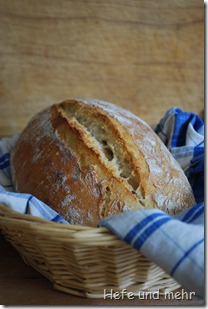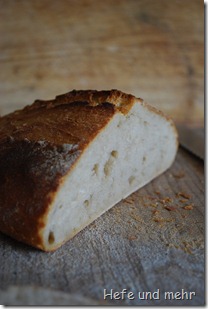 MC posted last week the portrait of the Baker John Tredgold , one of nine Bakers of the Bread Bakers Guild Team USA 2010. They train at the moment for the North American Louis Lesaffre Cup which takes place in Las Vegas in September.
MC posted last week the portrait of the Baker John Tredgold , one of nine Bakers of the Bread Bakers Guild Team USA 2010. They train at the moment for the North American Louis Lesaffre Cup which takes place in Las Vegas in September.
And he gave MC the recipe of the bread that won him a spot in the Team, including a excelsheet with the formula in Bakers percent. The bread sounds great (of course it do. It is a winner recipe). It contains three different preferments: Poolish, biga and sourdough. I love breads with different preferments because they give so much flavour to the bread. So I knew instantly that I had to try this recipe.
JT uses malted wheat flour type 85 (85 mg minerals per 10g flour) and all purpose flour. I only have excess to wheat flour type 550 (55 mg minerals) and type 1050 (105mg minerals), so I sat down with the excel sheet of the formula and start calculating. At the end I came down with a mixing ratio of type 1050 and 550 that should yield a similar dough as mixing type 85 and all purpose flour.
When mixing the dough I realized that the dough was very soft even before the second water addition. So I skip the second water addition and set the remaining 100g Water aside. At the end I had a hydration of only 66% but the dough felt like 75%. I do not know why the flour was not so thirsty this weekend. Maybe it was due to the warm weather? But the gluten structure was fine and the dough developed enough strength when folded three times during fermentation.
When writing the recipe down I forget to include malt in the formula. The dough rose nicely without but the next time I would like to test the recipe with 1% malt added.
At the end I get very delicious breads. I can understand that MCs grandchildren wolfed this bread down. I think our breads will not survive long either.
Before we finish all bread I sent this recipe to Susan’s weekly Yeastspotting.
JT’s Rustic bread with three preferments
yields 6 breads of 550g each
Biga
- 125g flour Type 1050
- 85g flour Type 550
- 125g water
- 0,5g fresh yeast
- 0,4g Salt (a very small pinch)
- 210g flour Type 550
- 230g water
- 0,5g fresh yeast Hefe
- 0,4g Salt (a very small pinch)
Sourdough
- 250g flour Type 1050
- 170g flour Type 550
- 230g water
- 210g firm sourdough starter (60% Hydration)
Teig
- 460g flour Type 1050
- 700g flour Type 550
- 750 g water (thats about 100g less then calculated)
- 10g fresh yeast
- 45g Salt
- whole Poolish
- whole Biga
- whole sourdough
Mix Biga, Poolish and sourdough and ferment for 10 to 12 hours at 25°C.
The next morning: Mix all ingredients for the dough at low speed for 2 min. Let the dough rest for 30 min (autolysis).Then knead the dough for about 2 min at low speed, then 4 min on high speed. Turn the dough on the counter and fold it. Now place the dough in a good oiled container.
Ferment for 1,5 hours. Fold the dough two times during this time (after 20 min and 40 min).
Divide the dough into 550g pieces and preshape to cylinders. Rest for 20 min.
Form batards and place them on couches.
Proof for 1,5 hour.
In the meantime heat the baking stone at 250°C.
Bake the breads for 35 min with steam.
Deutsch



Hallo,
eine Frage, könnte man im Haupteig anstelle des Weiten 1050 evt etwas Roggen nehmen?
LG
@Barbara: Klar! Oder du setzt anstelle eines Weizensauerteigs einen Roggensauerteig an. Dann bekommt das Brot zwar eine etwas säurliche Note, aber das schmeckt auch 🙂
Liebe Stefanie
danke für das tolle Rezept. beim Backen sind aber zwei Fragen aufgetaucht:
1. ich habe einen Ofen mit Dampfstoßfunktion. pro dampfstoß werden 100ml Wasser als Dampf in den Backraum abgegeben. wieviele Dampfstöße würdest du machen und wann? (dzt. mache ich es so, dass ich beim reingeben des Brotes bei 250 Grad einen setze und dann nach 12 Minuten , wenn ich auf 200 Grad reduziere nochmals – würdest du knapp vor Backende einen dritten machen?
2. wenn ich den Teig so lange gehen lasse (vor allem wenn er schon in der emailform ist), bilden sich an der oberfläche ganz viele 1 -2 mm große Löcher. soll ich vor dem backen die oberfläche mit einem pinsel und wasser verschließen? so befürchte ich, dass das Brot zuviel Feuchtigkeit verliert, bzw. geht es nur in de rForm auf, aber nicht mehr im Backofen.
danke
bernhard
@Bernhard: Ich würde zwei Dampfstöße machen, und kurz vor dem Backende die Ofentüre mal kurz öffnen, um den Dampf zu entfernen. Denn gegen Ende muss man bei trockener Hitze backen, um eine knusprige Kruste zu erziehlen.
Was die Löchlein in der Oberfläche angeht:Wenn das Brot auch im Ofen auch nicht mehr aufgeht, wird das Brot Übergare haben. Ein gutes Indiz, ob ein Brot backreif ist, ist der sogenannte Daumendrucktest (eine Beschreibung dazu gibt es hier im Text). Ich würde darum die Gehzeit mal auf 1 Stunde reduzieren.
danke.
den zweiten Dampfstoß kurz vor Ende ? oder 15 Minuten nach dem ersten?
@Bernhard: Ich würde den zweiten Dampfstoß etwa 10-15 Minuten nach dem ersten machen und 10 min vor Backende die Backofentüre kurz öffnen, um die Feuchtigkeit entweichen zulassen.
Hallo Stefanie
Habe dieses Brot gestern im Topf gebacken,einfach Klasse,auch dein Aromabrot schmeckt uns sehr gut.
Jetzt hät ich noch eine Frage, In meinem Kühlschrank wartet ein L.M. der dringend verarbeitet werden
sollte,könnte ich den in so ein Brot integrieren? Wäre sehr dankbar für einen Vorschlag.
Danke für deinen tollen Blog. Liebe Grüsse aus Ravensburg . Rene
b
@Rene: Schön, dass euch das Brot schmeckt 🙂 Du könntest die Biga durch den LM ersetzen, wenn das Mengenmäßig passt. Ansonsten würde ich die fehlende Wasser- und Mehlmenge dem Hauptteig einfach zuschlagen.
Pingback: Aroma-Brot | Hefe und mehr
Pingback: Hefe und mehr » Blog Archive » Engelskirchener Landbrot
Danke für diese tollen Rezepte – kann man die auch mit einem Brotbackautomaten machen=?
@billig kochen: Den Teig kann man bestimmt mit dem Automaten kneten, danach würde ich aber nach Rezept verfahren, den Teig in eine Schüssel umfüllen, regelmässig falten und die Brote im Ofen backen.
Pingback: Landbrot mit dreierlei Vorteig nach John Tredgold – Plötzblog
Pingback: kochtopf.twoday.net
Pingback: Gebacken: Landbrot mit dreierlei Vorteig nach John Tredgold « Plötzblog
@Stefan: Danke schön. Viel Erfolg beim Nachbacken, es ist nicht so kompliziert, wie es klingt.
@Chaosqueen: Das freut mich 😀
Ich habe das Brot am Sonntagabend gebacken und bin absolut begeistert.
Das Aroma ist wunderbar und Kruste und Krume gefallen mir ebenfalls ausgezeichnet.
WOW, Dein Brot sieht toll aus und scheint schön fluffig aufgegangen zu sein. Ein Rezept mit drei unterschiedlichen Vorteigen habe ich noch niegebacken. Werde es ganz oben auf die Nachbackliste setzen.
@Chaosqueen: Einkaufen war gestern wirklich anstrengend, aber dafür steht uns ja jetzt ein schönes Wochenende ins Haus. Das Brot kann man übrigens auch gut im Stück einfrieren und bei Bedarf aufbacken.
@MC: The formula is great! Thanks for the recipe!
@Mimi: Thank you1
That bread sounds really delicious!!
I am so glad the formula worked for you as well. This bread is indeed hard to beat, aroma-wise!
Brote mit mehreren Vorteigen mag ich auch besonders gerne, das Aroma ist unübertrefflich. Mein letzes Brot hatte zwei Vorteige und ein Quellstück.
Da ein ruhiges und einkaufsfreies Wochenende bevorsteht (ich muss gleich noch los) und ich alle Zutaten da habe, werde ich Dein Brot backen.
Ich freue mich schon auf’s Anschneiden.